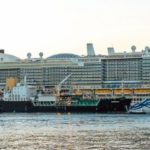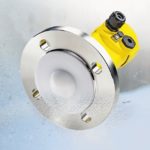Liquefied natural gas is booming – especially in the shipping and cruise industries. It is not only unprecedented ship sizes that make the new generation of container and cruise vessels so extraordinary. Their means of propulsion is no less remarkable. For the first time, a small number of them are crossing the world’s oceans with natural gas as fuel. Yet it is not only ship operators who are recognising the growing economic and ecological advantages of liquefied natural gas (LNG) and liquefied petroleum gas (LPG) over conventional fuels. Owners of truck fleets and industrial machines are also beginning to see LNG/LPG as an attractive energy source. In contrast to natural gas or crude oil, these gases can be transported flexibly by ship to remote destinations in any part of the world. Liquefied by cooling to -162 °C, the density of LNG is an impressive 450 kg/m3 – 600 times more than in its original form. Due to this reduction in volume, natural gas transport routes are essentially independent of the major pipelines.
Safety first
When handling liquefied gas, safety comes first. This substance is not only extremely cold but also flammable and explosive. Automation systems therefore play a special role in storage and delivery at the filling terminals. Reliable sensor data, in turn, ensures the quality and reliability of the automation systems. Comprehensive data evaluations help to reduce potential risks. This provides security and the resulting information allows optimal utilisation of processes, saving time and money.
It is not simply the extreme temperatures that make life difficult for measuring instruments used at sea or for liquefied gases. The media themselves are problematic: all petrochemical products are difficult to measure, mostly due to their typically small dielectric constants. The smaller the dielectric, the more challenging it becomes to get an exact measurement with radar. The level and pressure measurement technology, which is the only thing that can provide a reliable and accurate overview in such applications, must therefore be optimally prepared in several different respects.
Mechanically decoupled
Vegapuls 64 is an 80 GHz radar sensor that is ideally suited for non-contact measurement, as it measures the level completely independently of temperature, pressure and density. From the top of the housing to the measuring cell, it is extremely robust and equipped with high quality components down to the last detail. The key feature is its sturdy stainless steel construction, which thermally decouples the sensitive electronics inside the housing. Due to the more reliable separation from the process, the sensor can be used at process temperatures down to -196 °C. Ice does not form on the instrument, nor is there any condensation on the antenna system. In addition to cryogenic applications, the specially protected housing and flush antenna cover made from PTFE are additionally predestined for precise measurements in aggressive media, whether acids, alkalis or abrasive substances.
Dynamics in sight
The excellent dynamics of the high-frequency radar sensors also make a difference. Since liquefied gases only reflect emitted signals very weakly due to their low Dk values, the sensors have to reliably detect even the smallest of reflections. With their 120 dB, the 80 GHz radar sensors from Vega can do this particularly well. Due to their high dynamic range, they repeatedly set new standards in the detection of tiny signals. This is especially true when it comes to measuring hydrocarbons. The sensors measure virtually all media in the petrochemical industry, from crude oil to cryogenic liquefied gases, with high reliability despite their poor reflective properties.
Focused down to the tank bottom
Cryogenic containers are usually well insulated, i.e. double walled and vacuum insulated storage tanks made from stainless steel. The requirement that sensors must be separable from the process via a suitable armature or fitting, without interrupting the process, is typical of liquid gas applications. This requirement is mandatory
for liquid gas tanks on land. In the case of radar level measuring instruments, it means mounting on a ball valve. One of the strengths of Vegapuls 64 is its unique focusing. The radar beam can be aligned with almost pinpoint accuracy, so any influence on it is quite limited, even that of the ball valve. In fact, the valve doesn’t cause any interfering reflections at all. The 80 GHz radar sensor measures the exact filling level reliably, past internal vessel installations, and is also insensitive to condensate and build-up.
An industry changes its course
Liquid gas remains a niche fuel for ships and trucks. At sea, container giants still use a mixture of heavy oil and diesel oil, because converting to LNG would be too expensive. However, legislation is getting stricter and in the shipping industry LNG is considered to be the fuel of the future – with a whole host of advantages from reduced particulate matter, which in practice is close to zero, to considerably lower greenhouse gas emissions. In the event of an accident, neither LNG nor LPG damage the quality of the ocean water, nor are they toxic to aquatic organisms. If an emergency situation becomes critical, the gases simply evaporate.
Even at sea, some measured values are more important than others for the safe operation of processes – particularly in the case of ice-cold and combustible transport goods. Continuous measurement of the levels in the deck tanks and monitoring the multiple stages of the liquefaction process are becoming increasingly important, especially when the aim is to improve the operational safety of a ship’s “critical systems”. Safer and more efficient applications are the outcome. After all, even at sea, safety is not a condition that can be created once and then taken for granted – it is an ongoing process.
Online search: cppPC119vega
Hall 3, Booth C60









